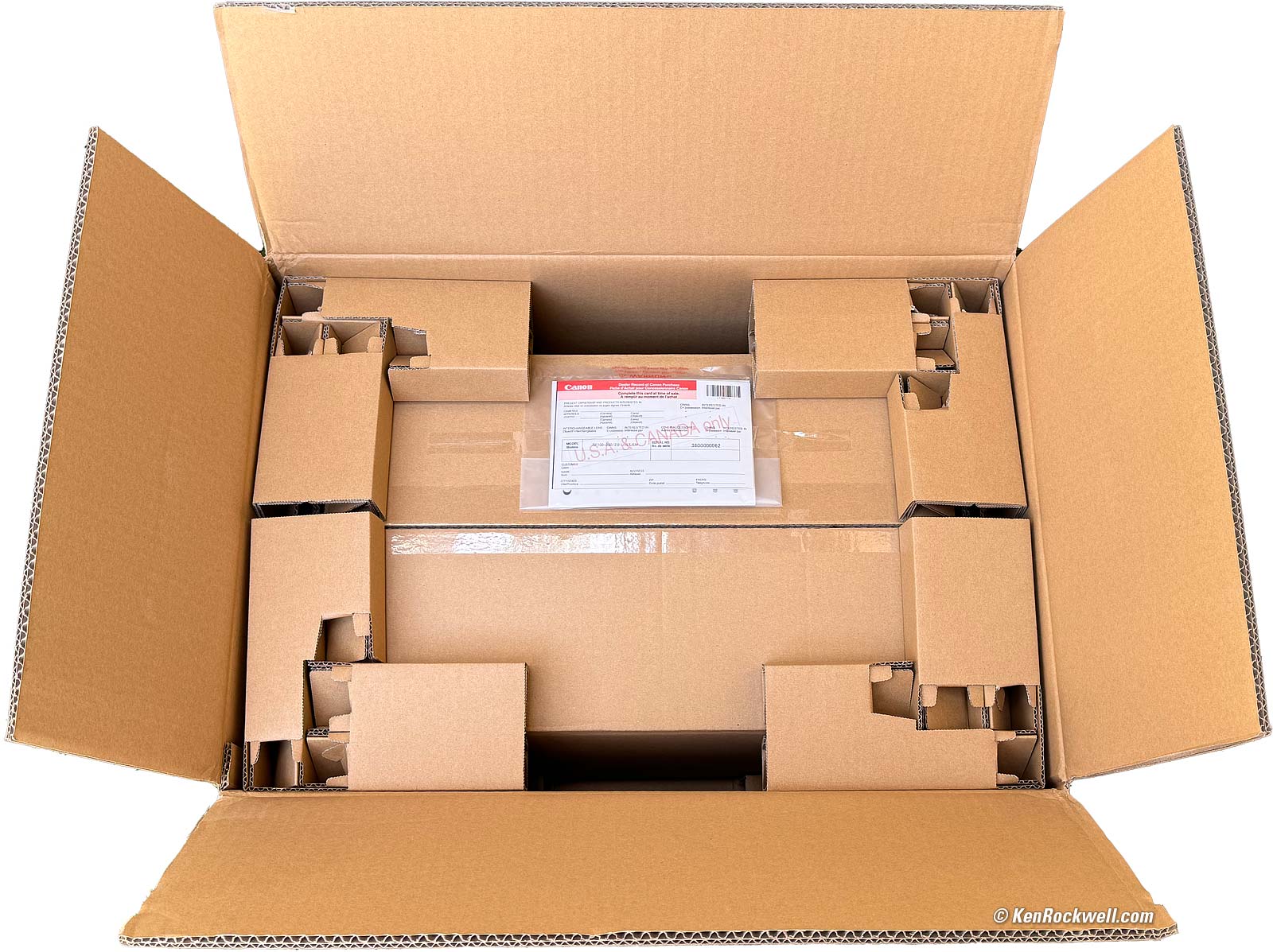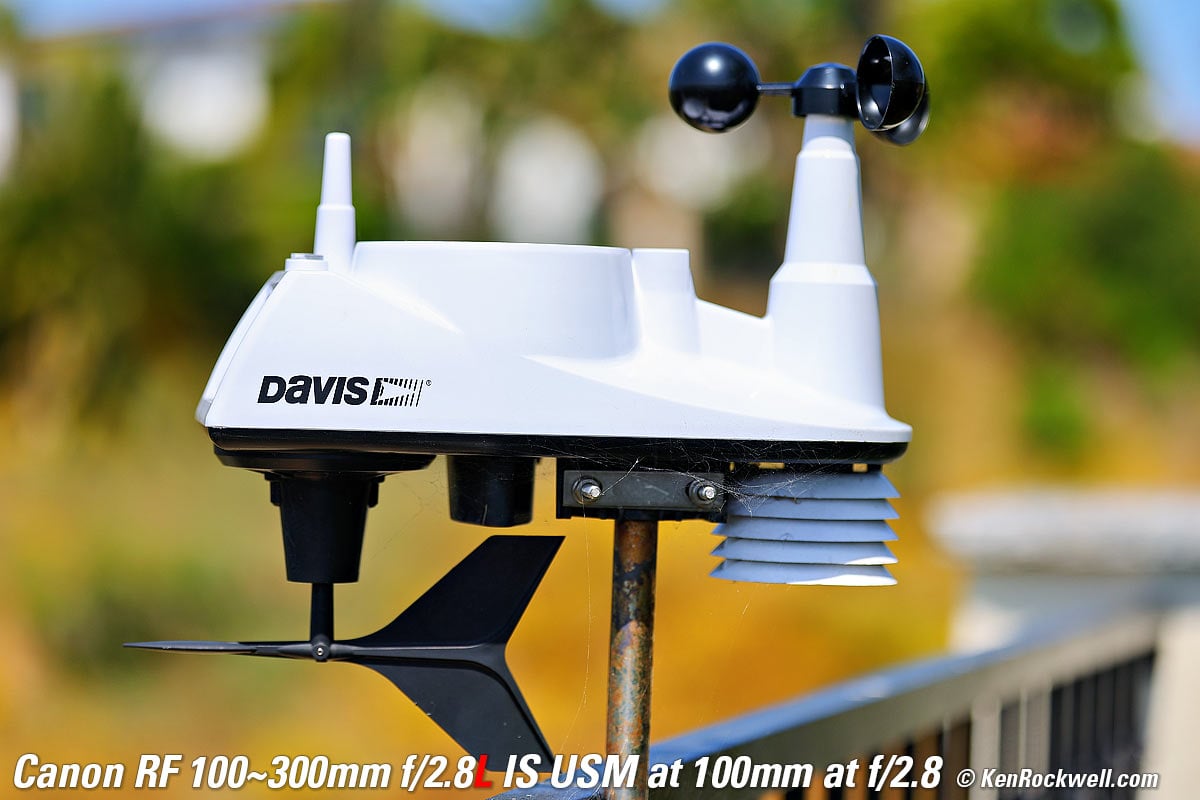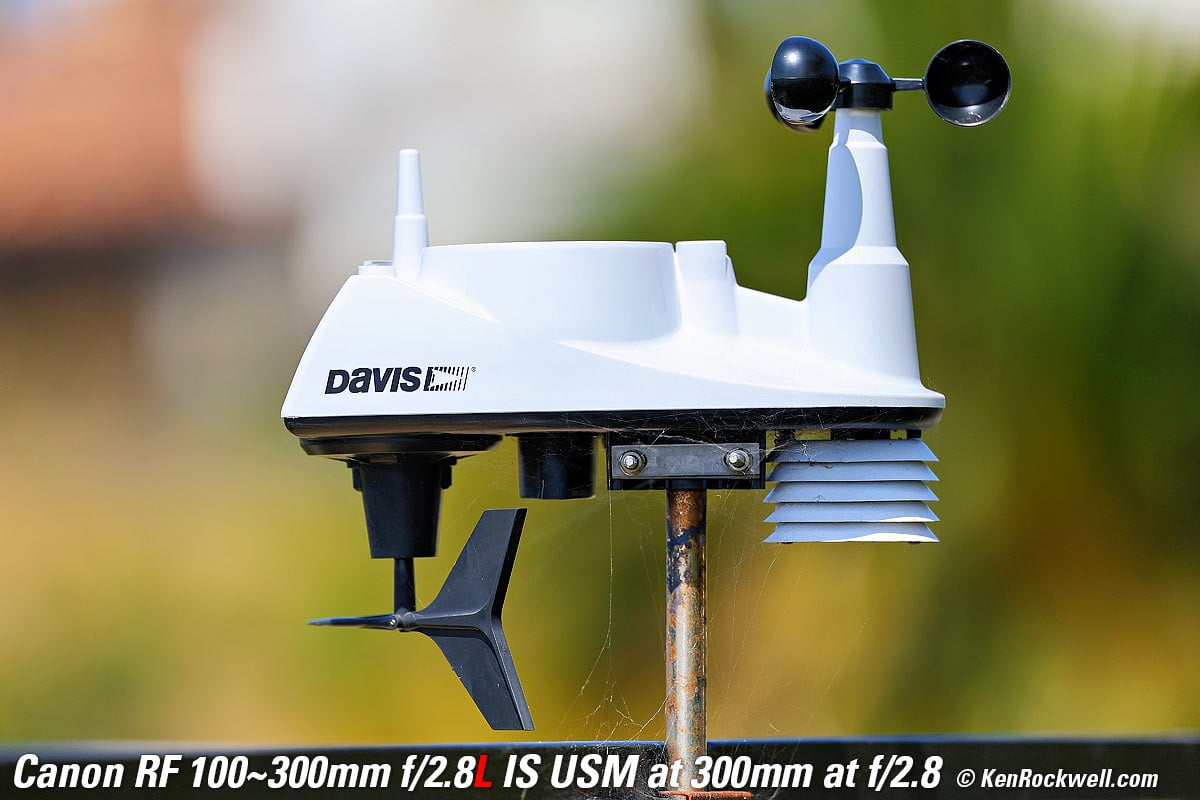Canon RF 100-300mm f/2.8L IS USM
(2023~)
Introduction New Good Bad Missing Specs
Performance Compared Recommendations
R3 R5 R5C R6 II R6 R R8 RP R7 R10 R50 R100
Bodies Compared RF Lenses EF Lenses Flash
Canon RF 100-300mm f/2.8L IS USM (metal 112mm front filter thread, 91.4 oz./5.7 lbs./2,590g, 5.9'/1.8m close focus, 0.16× macro ratio, $9,499). bigger.
I got mine at B&H. I'd also get it at Adorama, at Amazon or at Crutchfield, or get it used at eBay (How to Win at eBay).
This 100% all-content, junk-free website's biggest source of support is when you use those or any of these links to my personally approved sources I've used myself for way over 100 combined years when you get anything, regardless of the country in which you live — but I receive nothing for my efforts if you take the chance of getting it elsewhere. Canon does not seal its boxes in any way, so never buy an exotic lens like this at retail or any other source not on my personally approved list since you'll have no way of knowing if you're missing accessories, getting a defective, damaged, returned, dropped, incomplete, gray-market, store demo or used lens — and my personally approved sources allow for 100% cash-back returns for at least 30 days if you don't love your new lens. Especially with a lens like this you need to stick with approved sources because these exotic lenses are often pulled out to "demo" a zillion times at a local retail store. I've used many of these sources since the 1970s because I can try it in my own hands and return it if I don't love it, and because they ship from secure remote warehouses where no one gets to touch your new lens before you do. Buy only from the approved sources I've used myself for decades for the best prices, service, return policies and selection.
May 2024 Better Pictures Canon Reviews Mirrorless RF Lenses EF Lenses Flash All Reviews
Canon EF 300mm f/2.8L USM (1987 ~ 1999)
Sony vs. Nikon vs. Canon Full-Frame
Introduction top
Introduction New Good Bad Missing Specs
Performance Compared Recommendations
|
I buy only from these approved sources. I can't vouch for ads below. |
As we expect for a $10,000 lens, this lens' optics are flawless, autofocus is faster than my own eyes, bokeh is beautiful, it is amazingly free from spherochromatism and it's built to an incredibly high mechanical standard I haven't seen in years.
This amazing lens replaces a standard fixed 300mm f/2.8, adding the ability to zoom out. No longer will you have players running towards you and have to swap to your other body with your 70-200mm as they get closer. Bravo!
It becomes a 140-420mm f/4 with the RF 1.4× Extender teleconverter.
It becomes a 200-600mm f/5.6 with the RF 2× Extender teleconverter.
It replaces an EF 70-200mm f/2.8 on an EF 1.4× extender on an EF to RF adapter, resulting in a combo one stop faster. (The RF 70-200mm f/2.8 doesn't work with extenders so you have to use an EF 70-200mm f/2.8.)
This RF 100-300mm f/2.8L IS USM is exquisitely sharp and useful, however the one thing it doesn't do is focus closely. It only focuses as close as 6 feet (1.8 meters) at every focal length.
I got my RF 100-300mm f/2.8L IS USM at B&H. I'd also get it at Adorama, at Amazon or at Crutchfield, or get it used at eBay (How to Win at eBay).
New intro top
 World's first 100-300mm f/2.8 (Nikon has a 120-300mm f/2.8). The 1990s Canon EF 100-300mm f/5.6 was a plastic consumer lens, and the previous EF 300mm f/2.8L IS USM II couldn't zoom.
World's first 100-300mm f/2.8 (Nikon has a 120-300mm f/2.8). The 1990s Canon EF 100-300mm f/5.6 was a plastic consumer lens, and the previous EF 300mm f/2.8L IS USM II couldn't zoom.
Good intro top
 Almost instantenous autofocus!
Almost instantenous autofocus!
 Flawless optics, whcih I expected for $10,000.
Flawless optics, whcih I expected for $10,000.
 Exquisitely well made the way a lens is supposed to be, of almost all metal, and it's still lightweight.
Exquisitely well made the way a lens is supposed to be, of almost all metal, and it's still lightweight.
 Works brilliantly with either the RF 2× Extender or RF 1.4× Extender teleconverters, but only one at a time.
Works brilliantly with either the RF 2× Extender or RF 1.4× Extender teleconverters, but only one at a time.
 Metal filter threads mean 112mm filters glide on and off without cross threading. Align the threads, and then a flick of the wrist spins it home.
Metal filter threads mean 112mm filters glide on and off without cross threading. Align the threads, and then a flick of the wrist spins it home.
 Programmable Focus Preset button (back near the lens mount) lets you tap to refocus on home plate or your bird feeder immediately when there's action there.
Programmable Focus Preset button (back near the lens mount) lets you tap to refocus on home plate or your bird feeder immediately when there's action there.
 Four more programmable L-Fn buttons around the front of the lens, typically set to Focus Lock. (You set the function in your camera's menu system.)
Four more programmable L-Fn buttons around the front of the lens, typically set to Focus Lock. (You set the function in your camera's menu system.)
 The tripod collar has precise 90º click stops.
The tripod collar has precise 90º click stops.
 Focus limiter switch.
Focus limiter switch.
 Extra programmable control ring.
Extra programmable control ring.
 AF/MF switch.
AF/MF switch.
 Stabilizer switch.
Stabilizer switch.
 Image Stabilization rated 5.5 stops; 6 stops if your camera has internal stabilization.
Image Stabilization rated 5.5 stops; 6 stops if your camera has internal stabilization.
 Made in Japan. The quality is apparent when I photographed this lens in my studio,. It arrived without any dust for me to spot-out in Photoshop for my product photos. I kid you not; lenses that get offshored outside of Japan or Germany often have a lot more random white dust on them for me to spot for the photos you see in this review, which are all shot by me in my studio — these are not stock shots.
Made in Japan. The quality is apparent when I photographed this lens in my studio,. It arrived without any dust for me to spot-out in Photoshop for my product photos. I kid you not; lenses that get offshored outside of Japan or Germany often have a lot more random white dust on them for me to spot for the photos you see in this review, which are all shot by me in my studio — these are not stock shots.
 100% U.S.A.-based high-quality technical support at (800) OK-CANON.
100% U.S.A.-based high-quality technical support at (800) OK-CANON.
Bad intro top
 Big and expensive (it's actually pretty lightweight).
Big and expensive (it's actually pretty lightweight).
Missing intro top
 No focusing closer than 5.9 feet (1.8 meters).
No focusing closer than 5.9 feet (1.8 meters).
 No big leather sock to cover the front; instead it has an ordinary (but big 112mm) snap-in plastic front cap. I always find it easier and more secure to use a big sock rather than a fiddly snap-in cap.
No big leather sock to cover the front; instead it has an ordinary (but big 112mm) snap-in plastic front cap. I always find it easier and more secure to use a big sock rather than a fiddly snap-in cap.
 The lens' strap lugs are fixed; they don't pivot for better balance as they do on the older EF 300mm f/2.8 L.
The lens' strap lugs are fixed; they don't pivot for better balance as they do on the older EF 300mm f/2.8 L.
 No rear filter holder slot.
No rear filter holder slot.
 No variable manual focus speeds like on the EF 300mm f/2.8L.
No variable manual focus speeds like on the EF 300mm f/2.8L.
 No hard case; comes with a much more useful soft case.
No hard case; comes with a much more useful soft case.
Canon RF 100-300mm f/2.8L IS USM. bigger.
Specifications top
Introduction New Good Bad Missing Specs
Performance Compared Recommendations
I got my RF 100-300mm f/2.8L IS USM at B&H. I'd also get it at Adorama, at Amazon or at Crutchfield, or get it used at eBay (How to Win at eBay).
Camera Compatibility
This lens only works on Canon's EOS-R series of mirrorless cameras.
It works with either of the RF 2× Extender or RF 1.4× Extender teleconverters, but only one at a time.
It won't fit on, and cannot be adapted to, any DSLR because a DSLR has too much distance between its sensor and its lens mount flange.
Name specifications top
Canon calls this the RF100-300mm F2.8 L IS USM:
RF: Works only on Canon's EOS-R Mirrorless cameras.
L: Expensive as L.
IS: Image Stabilization.
USM: UltraSonic (autofocus) Motor.
Optics specifications top
Internal Optical Construction at 100mm. Fluorite, Aspherical and UD elements. [IS section]. Red Dashes show ASC Air-Sphere coatings.
23 elements in 18 groups.
 One fluorite element for extreme sharpness and freedom from chromatic aberrations.
One fluorite element for extreme sharpness and freedom from chromatic aberrations.
4 UD extra-low dispersion elements, which help reduce secondary axial chromatic aberration.
1 glass-moulded aspherical element.
 Internal zooming.
Internal zooming.
Super Spectra multicoating.
Air Sphere variable-refractive index coating (ASC).
 Front surface has a fluorine coating to resist dirt and smudges.
Front surface has a fluorine coating to resist dirt and smudges.
Diaphragm specifications top
Canon RF 100-300mm f/2.8L IS USM at 300mm at f/5.6. bigger.
9 rounded blades.
Electronically actuated.
Stops down to f/22.
Filters specifications top
Front 112mm filter thread.
No rear filter drawer.
Focal Length specifications top
100-300mm.
When used on Canon's APS-C cameras, it sees the same angles of view as a 160-480 mm lens sees when used on a full-frame or 35mm camera.
See also Crop Factor.
Angle of View specifications top
24º ~ 8º 15' diagonal on full frame.
20º ~ 6º 50 horizontal on full frame.
14º ~ 4º 35' vertical on full frame.
Autofocus specifications top
Two nano-USM focus motors.
Focus Scale specifications top
No.
Not on lens, but may be displayed in-camera.
Infinity Focus Stop specifications top
No.
You have to focus somehow to get precise focus at infinity, just like at every other distance.
Depth of Field Scales specifications top
No.
Not on lens, but may be displayed in-camera.
Infrared Focus Index specifications top
No.
Close Focus (distance from subject to image plane) specifications top
5.9 feet (1.8 meters).
Maximum Reproduction Ratio specifications top
1:6.25 (0.16 ×) at 300mm.
(1:16.7 (0.06 ×) at 100mm.)
Minimum Subject Field specifications top
At 300mm
8.7 x 5.9 inches.
222 x 149mm millimeters.
At 100mm
22.3 x 14.8 inches.
566 x 376 millimeters.
Image Stabilizer specifications top
Rated 5.5 stops improvement, 6 stops if your camera has internal stabilization.
Gives between 3½ to 4⅔ stops improvement in actual use.
Caps specifications top
E-112 front cap, included.
Rear Lens Dust Cap RF (p/n 2962C001), included.
Hood specifications top
Included Canon ET-124 hood for RF 100-300mm f/2.8L IS USM. bigger.
Included Canon ET-124 hood for RF 100-300mm f/2.8L IS USM. bigger.
ET-124 hood, included.
Case specifications top
Included LS100-300 soft case for Canon RF 100-300mm f/2.8L IS USM. bigger.
 It comes with a very nice and useful LS100-300 soft case, not the usual hard case.
It comes with a very nice and useful LS100-300 soft case, not the usual hard case.
It has a single shoulder strap on the back, perfect for carrying it into the stadium.
Size specifications top
5.1" ø maximum diameter × 12.7" extension from flange.
128 mm ø maximum diameter × 323.4 mm extension from flange.
Weight specifications top
93.5 oz. (5.8 pounds or 2,650 g).
Teleconverters specifications top
 Works with either the RF 2× Extender or RF 1.4× Extender teleconverter, but only one at a time.
Works with either the RF 2× Extender or RF 1.4× Extender teleconverter, but only one at a time.
Announced specifications top
Thursday, 20 April 2023,12:04 AM NYC Time.
Promised for specifications top
Late May 2023.
Included specifications top
Lens.
Rear Lens Dust Cap RF (p/n 2962C001).
Soft Case LS100-300.
Canon's Model Numbers specifications top
Product code: 6055C002 (6055C001 in Japan).
Model number: RF100-300LIS.
JAN code: 4549292-216165.
Price, U. S. A. specifications top
May 2024
$9,499 at Adorama and at B&H.
I got my RF 100-300mm f/2.8L IS USM at B&H. I'd also get it at Adorama, at Amazon or at Crutchfield.
About $8,900 used if you know How to Win at eBay.
April 2023
$9,499 at Adorama and at B&H.
Packaging specifications top
Canon RF 100-300mm f/2.8L IS USM. bigger.
This double-wall corrugated outer box is 22" (56 cm) wide by 15" (38cm) tall by 15½" (39cm) deep.
Inside there are corrugami corners that hold a smaller box, inside of which lies the padded case with the lens inside:
Getting a Legal U. S. A. Version top
Sample Images Introduction New Good Bad Missing Format Compatibility Specifications Accessories
Unboxing USA Version Performance Compared User's Guide Recommendations More
I got my RF 100-300mm f/2.8L IS USM at B&H. I'd also get it at Adorama, at Amazon or at Crutchfield, or get it used at eBay (How to Win at eBay).
This section applies in the U. S. A. only.
U. S. A. warranty card taped inside the box as you open it. bigger.
Your new 100-300mm f/2.8L must include a U. S. A. warranty card like the one shown taped in the box from Canon U.S.A., Inc. It should be taped onto the top of the inside box as you open the larger box. The serial number on the card must match the serial number on the bottom of your lens.
If you have no card or the serial number doesn't match, you got ripped off with a gray market version intended to be sold in another country. This is why I never buy from any place other than my personally approved sources. You just can't take the chance of buying elsewhere, especially at any retail store where strangers have probably opened your box and played with your lens, because non-U. S. A. versions have no warranty in the U. S. A., and you probably won't be able to get firmware or service for it — even if you're willing to pay out-of-pocket for it when you need it!
Just some of this lens' world travels. The serial number is the third line of the top left sticker. bigger.
What you can't see are stickers elsewhere, showing the lens shipping from Japan via United Airlines to Canon USA in Aurora, Illinois, who then sent it to B&H's warehouse in New Jersey, who then sent it to me. These lenses are special enough that they ship by themselves, not as part of bulk shipments.
The serial number on the box doesn't have to match, but it should. If not, it means a shady dealer took things out of boxes and was too sloppy to put them back correctly — and it means you got a used lens if anyone other than you took it out of the box.
Shifty dealers may include color copies of a card from a legitimate U. S. A. product in a gray-market box, hoping you won't check serial numbers and catch their fraud. A card with the wrong serial number means nothing other than that you have no warranty coverage.
If a gray market version saves you $3,000 the risk might be worth it, but for $1,000 or less I wouldn't risk having no warranty or support.
Always be sure to check yours while you can still return it, or just don't buy from unapproved sources and never at retail so you'll be able to have your camera serviced and get free updated firmware as needed. Get yours from the same places I do and you won't have a problem.
Performance top
Introduction New Good Bad Missing Specs
Performance Compared Recommendations
I got my RF 100-300mm f/2.8L IS USM at B&H. I'd also get it at Adorama, at Amazon or at Crutchfield, or get it used at eBay (How to Win at eBay).
Overall performance top


 This 100-300mm f/2.8L IS USM is superb, as we'd expect for almost ten grand. Not only are its optics flawless and its autofocus faster than my own eyes, it's built with a level of mechanical quality I haven't seen in years. It's solid metal the lenses are supposed to be made.
This 100-300mm f/2.8L IS USM is superb, as we'd expect for almost ten grand. Not only are its optics flawless and its autofocus faster than my own eyes, it's built with a level of mechanical quality I haven't seen in years. It's solid metal the lenses are supposed to be made.
 Not only is it made almost entirely of metal, it has 90º click stops on its tripod collar and it's also super lightweight as these things go.
Not only is it made almost entirely of metal, it has 90º click stops on its tripod collar and it's also super lightweight as these things go.
The only thing it doesn't do is focus closely; this is not a macro lens as are so many zooms today.
Autofocus performance top
 Autofocus is faster than my own eyes. It's not instantaneous, but it pops from close-focus distance to infinity (or vide versa) immediately, faster than my own eyes can accommodate that large a change in distance.
Autofocus is faster than my own eyes. It's not instantaneous, but it pops from close-focus distance to infinity (or vide versa) immediately, faster than my own eyes can accommodate that large a change in distance.
Bravo!
Manual Focus performance top
Manual focusing is entirely electronic; the manual focus ring isn't connected to anything other than a digital encoder.
Canon still hasn't mastered instant manual-focus override. In SERVO AF it will continue to hunt the instant you stop turning the focus ring. It does have instant override in ONE SHOT and of course in the manual focus mode.
How to Get Manual-Focus Override.
Focus Breathing performance top
Focus breathing is the image changing size as focused in and out. It's important to cinematographers that the image not breathe because it looks funny if the image changes size as focus gets pulled back and forth between actors. If the lens does this, the image "breathes" by growing and contracting slightly as the dialog goes back and forth.
The image from this 100-300mm f/2.8L IS USM grows as focused more closely. The effect is greater at 100mm, where it's minor to moderate, and it's much less at 300mm, where it's minor.
Focus Distance Recording performance top
 The focused distance is recorded in the EXIF data.
The focused distance is recorded in the EXIF data.
I read this in the lower left of my screen in Photoshop's lens correction filter.
Bokeh performance top
 Bokeh, the feel, character or quality of out-of-focus areas as opposed to how far out of focus they are, is excellent. Of course things get very far out of focus at 300mm at f/2.8, and they're also soft as well as simply out of focus. Bravo!
Bokeh, the feel, character or quality of out-of-focus areas as opposed to how far out of focus they are, is excellent. Of course things get very far out of focus at 300mm at f/2.8, and they're also soft as well as simply out of focus. Bravo!
Here are photos from headshot distance wide-open. I'm focused on the DAVIS logo. Click any for the © camera-original file:
Made-in-U. S. A. Davis 6357 Wireless Sensor Suite (use with WeatherLink console), 08 May 2024. Canon EOS R6 Mk II at 1/2,500 at Auto ISO 100, +0.7 stops exposure compensation (LV 14.4), all three. Click any for the camera-original © file.
As always, if you want to throw the background as far out of focus as possible, shoot at 300mm at f/2.8 and get as close as possible.
Distortion performance top
 Even with distortion correction turned off, the RF 100-300mm f/2.8L IS USM has almost no visible distortion. Except for some mild to moderate barrel distortion at 100mm and some barely visible pincushion distortion at 300mm, I doubt you'll ever notice any.
Even with distortion correction turned off, the RF 100-300mm f/2.8L IS USM has almost no visible distortion. Except for some mild to moderate barrel distortion at 100mm and some barely visible pincushion distortion at 300mm, I doubt you'll ever notice any.
Turn correction on, and it goes away completely.
For more critical scientific use, use these corrections in Photoshop's lens correction filter to JPG images.
These aren't facts or specifications, they are the results of my research that requires hours of photography and calculations on the resulting data.
On Full-Frame at 30' (10m) |
Correction factor to use with images made with correction ON in R6 II |
Correction factor with uncorrected images |
100mm |
±0.00 | +1.50 |
135mm |
±0.00 | ±0.00 |
200mm |
+0.10 | -0.60 |
300mm |
±0.00 | -1.00 |
© 2024 KenRockwell.com. All rights reserved.
Ergonomics performance top
Canon RF 100-300mm f/2.8L IS USM. bigger. |
Canon RF 100-300mm f/2.8L IS USM. bigger. |
This is is a whopper of a lens. I hand hold it easily, but I'm a big guy with big hands.
It takes two fingers to zoom. The direct mechanical zoom ring is huge and doesn't just flick back and forth; there is a lot of glass moving around as you zoom so it takes two fingers.
The zoom ring is so huge that people con manitas (with little hands) may not be able to wrap far enough around the zoom ring to be able to manipulate it with just fingers while keeping your wrist stationary. Folks with smaller hands may need to rotate their wrists along with it.
The zoom ring, at its minimum, is 4¼" (108mm) in diameter, or 13.4" (34 cm) in circumference. Hopefully you can spread your thumb at least 8" (20cm) away from your forefinger. I can reach 10" (25 cm) so just my two fingers can zoom it while my wrist remains stationary.
It's hard to find the focus ring by feel. It takes practice to know just where to find it because the ribbing is so fine that it doesn't stand out by feel. The front programmable focus lock buttons and the extra control ring have coarser knurling so they're easy to find by feel.
There's no always-responsive instant manual-focus override in SERVO AF mode; the lens keeps trying to focus as soon as you stop turning the ring. Use ONE SHOT and you do have instant manual override.
Falloff performance top
 Falloff is invisible.
Falloff is invisible.
If you shoot raw data rather than JPG images, whatever software you use to create visible images from raw data may or may not correct this as is done in-camera as JPGs. You're on your own there; I don't bother with raw data.
I've greatly exaggerated the falloff by shooting a gray field and placing these on a gray background; it will not look this bad in actual photos of real things:
Falloff on full-frame at infinity, correction at its default of ON:
© 2024 KenRockwell.com. All rights reserved. |
If you shoot raw data rather than JPG images, whatever software you use to create visible images from raw data may or may not correct this as is done in-camera as JPGs. You're on your own there; I don't bother with raw data.
If you go out of your way to turn off the correction,there is some very minor falloff at f/2.8 at all focal lengths, and more at 300mm at f/2.8, but it's still not particularly awful in actual shooting. Here's what you get if you try to exaggerate it with flat gray areas:
Falloff on full-frame at infinity, correction deliberately turned OFF:
© 2024 KenRockwell.com. All rights reserved. |
Filters, use with performance top
This lens uses ordinary 112mm front screw-in filters. It has no filter drawer as these lenses had back in the days of film.
There's no need for thin filters with a lens this long.
Go ahead and use your standard rotating polarizer and grad filters.
Be careful; a lens this long and fast can be sensitive to poorly made filters at 300mm.
Check any filter your hope to use with this lens for flatness. Take photos with and without the filter, or even better, just hold it over the front of one side of a pair of binoculars or a small telescope. The image should be perfectly clear with or without the filter. If the filter is even slightly unflat, the image seen through the telescope will look awful! So long as it looks good when held in front of your scope, it will be perfect for pictures. This test instantly makes even slightly bad filters look absolutely awful, so if it looks OK through your scope, you're good.
Flare & Ghosts performance top
This RF 100-300mm f/2.8L IS USM has the usual amount of ghosts if you point it at brilliant sources of light.
See examples at Sunstars.
Lateral Color Fringes performance top
There are no color fringes when shot as JPG with the default Chromatic Aberration Correction left ON, which is a setting inside the Digital Lens Optimizer under Lens Aberration Correction in your camera's menu system.
Of you go out of your way to turn this OFF (or shoot raw and then use non-manufacturer software to process that data into images) then there is a tiny bit of green/magenta fringing at 100mm, less at 135mm, none at 135mm, and then a tiny bit of magenta/green fringing at 300mm.
If you shoot raw data rather than JPG images you may — or may not — be responsible to correct this on your own.
Lens Corrections performance top
Other cameras may vary as the years roll on, but my EOS R3, R5, R5C, R6 II, R6, R, R8, RP, R7, R10, R50 and R100 all have options to correct for falloff (Peripheral Illumination Correction), Distortion and a Digital Lens Optimizer which corrects for a suite of other aberrations.
Falloff and the Digital Lens Optimizer are ON by default.
This lens has very little distortion, so Distortion correction is OFF by default. Feel free to turn it on for more critical use.
If you turn off the Digital Lens Optimizer, you are then offered à la carte ON/OFF options for Chromatic Aberration Correction and Diffraction Correction.
If you shoot raw data rather than JPG images, whatever software you use to create visible images from raw data may or may not correct these as is done in-camera as JPGs. You're on your own there; I don't bother with raw data.
Macro Performance performance top
 This lens does not get very close at all, but it is sharp. Here's how close it gets on full frame:
This lens does not get very close at all, but it is sharp. Here's how close it gets on full frame:
Wide-Open at f/2.8
It doesn't get very close, while it is sharp at f/2.8. Of course the depth of field is about the thickness of a sheet of paper, so almost nothing is in focus, as is the case with all 300mm f/2.8 lenses this close:
Casio G-Shock Solar Atomic Watch at close-focus distance, 08 May 2024. Canon EOS R6 Mk II at 1/2,500 at Auto ISO 100, +1.3 stops exposure compensation (LV 14.4). bigger or camera-original © file.
1,200 × 900 pixel (5× magnification) crop from above. bigger or camera-original © file.
If this 1,200 × 900 pixel crop is about 3" (7.5cm) wide on your screen, then the complete image printed at this same large magnification would be about 10 × 15" (25 × 38cm).
If this 1,200 × 900 pixel crop is about 6" (15cm) wide on your screen, then the complete image printed at this same extreme magnification would be about 20 × 30" (50 × 75cm).
If this 1,200 × 900 pixel crop is about 12" (30cm) wide on your screen, then the complete image printed at this same insanely high magnification would be about 40 × 60" (1 × 1.5 meters).
At f/8
Of course we get more in focus at f/8, but there's still almost nothing in focus and again, this is the case for all f/2.8 300mm lenses:
Casio G-Shock Solar Atomic Watch at close-focus distance, 08 May 2024. Canon EOS R6 Mk II at 1/320 at Auto ISO 100, +1.3 stops exposure compensation (LV 14.4). bigger or camera-original © file.
1,200 × 900 pixel (5× magnification) crop from above. bigger or camera-original © file.
Now you can see all the dust so expertly rendered in focus.
If this 1,200 × 900 pixel crop is about 3" (7.5cm) wide on your screen, then the complete image printed at this same large magnification would be about 10 × 15" (25 × 38cm).
If this 1,200 × 900 pixel crop is about 6" (15cm) wide on your screen, then the complete image printed at this same extreme magnification would be about 20 × 30" (50 × 75cm).
If this 1,200 × 900 pixel crop is about 12" (30cm) wide on your screen, then the complete image printed at this same insanely high magnification would be about 40 × 60" (1 × 1.5 meters).
Mechanical Quality performance top
Canon RF 100-300mm f/2.8L IS USM. bigger.
 This lens is made as we expect for a $10,000 lens, of all metal with no shortcuts. Bravo!
This lens is made as we expect for a $10,000 lens, of all metal with no shortcuts. Bravo!
Finish
Off-white fine-textured splattery paint.
Hood
Plastic hood with a big rubber bumper and a metal thumb screw to keep it attached.
Front Bumper
Rubber.
Filter Threads
Metal!
Hood Bayonet Mount
Metal.
Outer Barrel (all of about six sections)
Solid metal!!!
Front Black Focus-Lock Button Ring
All rubber, with the buttons under the same rubber cover.
Front White Programmable Control Ring
Plastic.
Zoom Ring
Rubber-covered metal.
Focus Ring
Rubber-covered.
Slide Switches & Their Facsicia
Plastic.
Rear Barrel Exterior
Section with focus distance window: plastic.
Tripod Collar & Foot
All metal, except the lock screw grip is oddly plastic.
The black part atop the foot is a rubber pad for carrying.
Identity
Printed around rear of lens barrel, also "100-300" printed on top of tripod collar.
Internals
Seem like all metal!
Dust Gasket at Mount
Yes.
Mount
Chromed metal.
Markings
Just paint; nothing's engraved.
Serial Number
Serial Number Plate on Bottom of Lens (greatly enlarged). bigger.
Engraved on a silver metal plate stuck in a recess in the bottom of the barrel.
Date Code
None found.
Noises When Shaken
Mild clunking.
Made in
Made in Japan.
Sharpness performance top
Lens sharpness has nothing to do with picture sharpness; every lens made in the past 100 years is more than sharp enough to make super-sharp pictures if you know what you're doing. The only limitation to picture sharpness is your skill as a photographer. It's the least talented who spend the most time worrying about lens sharpness and blame crummy pictures on their equipment rather than themselves. Skilled photographers make great images with whatever camera is in their hands; I've made some of my best images of all time with an irreparably broken camera! Most pixels are thrown away before you see them, but camera makers don't want you to know that.
If you're not getting ultra-sharp pictures with this, be sure not to shoot at f/11 or smaller where all lenses are softer due to diffraction, always shoot at ISO 100 or below because cameras become softer at ISO 200 and above, avoid shooting across long distances over land which can lead to atmospheric heat shimmer, be sure everything is in perfect focus, set your camera's sharpening as you want it (I set mine to the maximum) and be sure nothing is moving, either camera or subject. If you want to ensure a soft image with any lens, shoot at f/16 or smaller at ISO 1,600 or above at default sharpening in daylight of subjects at differing distances in the same image.
People worry waaaaay too much about lens sharpness. It's not 1968 anymore when lenses often weren't that sharp and there could be significant differences among them; ever since about 2010 all new lenses are all pretty much equally fantastic.
 Yes, this lens is always ultra-sharp, especially wide-open at f/2.8 which is the whole reason you buy a monster lens like this.
Yes, this lens is always ultra-sharp, especially wide-open at f/2.8 which is the whole reason you buy a monster lens like this.
Lens-alone MTF wide-open at 10 cyc/mm (black) and 30 cyc/mm (blue). Sagittal (solid) and meridional (dashed).
Spherochromatism performance top
Spherochromatism, also called secondary spherical chromatic aberration or "color bokeh," is an advanced form of spherical and chromatic aberration in a different dimension than lateral chromatic aberration. It happens mostly in fast normal and tele lenses when spherical aberration at the ends of the color spectrum are corrected differently than in the middle of the spectrum. Spherochromatism can cause colored fringes on out-of-focus highlights, usually seen as green fringes on backgrounds and magenta fringes on foregrounds. Spherochromatism is common in fast lenses of moderate focal length when shooting contrasty items at full aperture. It goes away as stopped down.
 It has almost no spherochromatism, bravo!
It has almost no spherochromatism, bravo!
Mondaine A132.30348.11SBB at close-focus distance, 08 May 2024. Canon EOS R6 Mk II at 1/4,000 at Auto ISO 100, +1 stop exposure compensation (LV 15.0). bigger or camera-original © file.
1,200 × 900 pixel (5× magnification) crop from above. bigger or camera-original © file.
If this 1,200 × 900 pixel crop is about 3" (7.5cm) wide on your screen, then the complete image printed at this same large magnification would be about 10 × 15" (25 × 38cm).
If this 1,200 × 900 pixel crop is about 6" (15cm) wide on your screen, then the complete image printed at this same high magnification would be about 20 × 30" (50 × 75cm).
If this 1,200 × 900 pixel crop is about 12" (30cm) wide on your screen, then the complete image printed at this same extreme magnification would be about 40 × 60" (1 × 1.5 meters).
Image Stabilization performance top
 Optical Image Stabilization (OIS, IS or VR (Vibration Reduction)) works great, giving me between 3½ to 4⅔ stops of real-world improvement.
Optical Image Stabilization (OIS, IS or VR (Vibration Reduction)) works great, giving me between 3½ to 4⅔ stops of real-world improvement.
I get 100% perfect tripod-equivalent sharpness most of the time at 1/8 at 100mm, 1/15 at 180mm and 1/50 at 300mm with stabilization, but need to shoot at 1/250 at 100mm and 180mm or 1/500 at 300mm to get about the same results.
"Percent Perfectly Sharp Shots" are the percentage of hand-held, free-standing with no support or bracing, frames with 100% perfect tripod-equivalent sharpness as viewed at 300%. Hand tremor is a random occurrence, so at marginal speeds some frames will be perfectly sharp while others will be in various stages of blur — all at the same shutter speed.
This rates what percentage of shots are perfectly sharp, not how sharp are all the frames:
At 100mm
| % Perfectly Sharp Shots | 1s |
1/2 |
1/4 |
1/8 |
1/15 |
1/30 |
1/60 |
1/125 |
1/250 |
1/500 |
| Stabilization ON | 0 |
17 |
50 |
83 |
92 |
100 |
100 |
100 |
100 |
100 |
| Stabilization OFF | 0 |
0 |
0 |
0 |
0 |
17 |
0 |
67 |
83 |
100 |
I see a 4⅔ stop real-world improvement.
At 180mm
| % Perfectly Sharp Shots | 1/2 |
1/4 |
1/8 |
1/15 |
1/30 |
1/60 |
1/125 |
1/250 |
1/500 |
| Stabilization ON | 0 |
0 |
0 |
75 |
100 |
100 |
100 |
100 |
100 |
| Stabilization OFF | 0 |
0 |
0 |
0 |
14 |
33 |
23 |
67 |
100 |
I see a 4¼ stop real-world improvement.
At 300mm
| % Perfectly Sharp Shots | 1/4 |
1/8 |
1/15 |
1/30 |
1/60 |
1/125 |
1/250 |
1/500 |
1/1,000 |
| Stabilization ON | 0 |
0 |
42 |
50 |
100 |
100 |
100 |
100 |
100 |
| Stabilization OFF | 0 |
0 |
0 |
0 |
0 |
0 |
17 |
67 |
100 |
I see a 3½ stop real-world improvement.
Sunstars performance top
With a 9-bladed rounded diaphragm, I get 18-point sunstars on brilliant points of light at the smallest apertures.
Ignore the vertical smear at large apertures. This is a sensor artifact called interline transfer smear and is a camera, not a lens, defect.
Click any to enlarge:
Click any to enlarge.
Teleconverters performance top
 It works great with either RF extender.
It works great with either RF extender.
Canon is so serious about how great it works they even provide MTF curves to prove it. Personally this is the only thing I haven't tried myself with this lens; but other lenses I've used with converters work so well on the EOS-R system that I have no reason to believe the sharpness and autofocus speed is anything less than spectacular.
It becomes a 140-420mm f/4 with the RF 1.4× Extender:
Lens with RF 1.4× Extender MTF wide-open at 10 cyc/mm (black) and 30 cyc/mm (blue). Sagittal (solid) and meridional (dashed).
And it becomes a 200-600mm f/5.6 with the RF 2× Extender:
Lens with RF 2× Extender MTF wide-open at 10 cyc/mm (black) and 30 cyc/mm (blue). Sagittal (solid) and meridional (dashed).
Tripod Collar & Foot performance top
Tripod Foot With ¼″ × 20 TPI and ⅜″ × 16 TPI Threads. bigger.
 The tripod collar is all metal and very precisely made.
The tripod collar is all metal and very precisely made.
The collar doesn't come off the lens.
It looks like the foot could be removed with an Allen key, but that's not intended to be done by we photographers in the field. Leave it on; the foot is also a carrying handle with a rubber grip when you turn it over!
The foot has both ¼″ × 20 TPI and ⅜″ × 16 TPI tripod threads.
The thumb friction lock works marvelously. When free the lens glides easily, and only the lightest touch is needed to lock it.
 There are precise 90º clicks.
There are precise 90º clicks.
Bravo!
Compared top
Introduction New Good Bad Missing Specs
Performance Compared Recommendations
I got my RF 100-300mm f/2.8L IS USM at B&H. I'd also get it at Adorama, at Amazon or at Crutchfield, or get it used at eBay (How to Win at eBay).
This new RF 100-300mm f/2.8L IS USM is a little longer and heavier than older fixed 300mm f/2.8 lenses, however it zooms and focuses closer which more than makes up the difference for practical use.
RF 100-300mm f/2.8L IS USM |
|||
Anni |
2023- |
2011-2022 |
1987-1999 |
Zooms? |
YES |
No |
No |
Filters |
52mm drop-in |
48mm drop-in |
|
Close Focus |
5.9' 1.8m |
6.6' 2m |
10' 3m |
Macro Ratio |
0.16× |
0.18× |
0.11× |
Weight |
91.4 oz. 5.7 lbs. 2,590g |
82.9 oz. 5.2 lbs. 2,350g |
100.7 oz. 6.3 lbs. 2,855g |
Length |
12.7" 323mm |
9.8" 248mm |
10" 253mm |
Price, 4/2023 |
About $4,000 used if you know How to Win at eBay |
About $1,400 used if you know How to Win at eBay |
|
Price, 5/2024 |
About $3,150 used if you know How to Win at eBay |
About $1,250 used if you know How to Win at eBay |
User's Guide top
Sample Images Introduction New Good Bad Missing Format Compatibility Specifications Accessories
Unboxing USA Version Performance Compared User's Guide Recommendations More
I got my RF 100-300mm f/2.8L IS USM at B&H. I'd also get it at Adorama, at Amazon or at Crutchfield, or get it used at eBay (How to Win at eBay).
See also Canon's own RF 100-300mm f/2.8L IS USM User's Manual.
L-Fn / PRESET / RECALL Switch user's guide top
Canon RF 100-300mm f/2.8L IS USM. bigger.
This switch at the top controls what this button at the back of the lens does:
Canon RF 100-300mm f/2.8L IS USM. bigger.
The settings are:
L-Fn: Makes the rear white button do the same thing as the front four buttons do, usually Focus Lock, as selected in your camera's menu system.
PRESET: This position saves the focused distance when you tap the white button. Select PRESET, focus on your intended subject, and tap the rear white button to store the distance.
RECALL: Immediately focuses the lens to the distance you preset above. One tap, and bam!, the lens resets to your previously stored distance.
Hint: It remembers this distance when you turn off the camera, but if you take the lens off the camera, it resets this distance back out to just beyond infinity. If you remount the lens, remember to save your preferred distance again.
Full / 6m-∞ Switch user's guide top
This is a focus limiter.
Leave it in FULL.
The 6m-∞ position prevents the lens from autofocusing closer than 6 meters (20 feet). Use this setting only if you're having a problem with the lens attempting to focus on irrelevant close items, or if for some reason the lens is "hunting" from near to far looking for distant subjects.
AF - MF Switch user's guide top
AF: Auto Focus. You have instant manual focus override by turning the focus ring at any time. It will try to ignore minor accidental bumps.
AF: Auto Focus, with instant manual focus override in ONE SHOT if set.
MF: Manual Focus only.
STABILIZER Switches user's guide top
ON / OFF
Leave it ON unless you're on a very sturdy tripod, or if you're making exposures longer than a second on any kind of tripod.
STABILIZER MODE
MODE 1 (For still subjects): Corrects camera movement in all directions.
MODE 2 (For panning on smooth motion like trains and airplanes): When panning, corrects camera movement perpendicular to the direction of panning.
MODE 3 (For sports & animals): Same as MODE 2, but only compensates during exposure, not as you're viewing. It saves energy and is better for random motion.
Lens Strap
The included Canon Wide Lens Strap B attaches to the lugs on the lens itself.
Using this lens strap is is a better, more balanced way to carry this when on a camera rather than using a strap on the camera.
The included soft case has its own even more padded shoulder strap.
Recommendations top
Introduction New Good Bad Missing Specs
Performance Compared Recommendations
I got my RF 100-300mm f/2.8L IS USM at B&H. I'd also get it at Adorama, at Amazon or at Crutchfield, or get it used at eBay (How to Win at eBay).
Not only does this advance the old fixed 300mm f/2.8 lens, it also gives an extra stop of speed to people who used to shoot their 70-200mm f/2.8 lenses with a 1.4× teleconverter — and neither of the new RF 70-200mm f/2.8 or RF 70-200mm f/4 lenses work with any RF converters anyway, so those people needed the EF 70-200/2.8 and an EF 1.4× converter just to get a 100-300mm f/4.
A Wimberly gimbaled head is a dream for any and everyone with the luxury of shooting from a fixed location.
I use a clear (UV) protective filter instead of a cap (exactly like an iPhone) so I'm always ready to shoot instantly. I only use a cap when I throw this in a bag with other gear without padding — which is never. The UV filter never gets in the way, and never gets lost, either.I'd use a 112mm B+W MRC 010 MRC Master UV filter to protect this lens. The Nikon 112mm NC (Neutral Clear) is also an excellent filter.
You may also want a 112mm Polarizer. I'd trust the Nikon 112mm Polarizer and the B+W 112mm Polarizer, but be sure to perform the telescope test (hold the filter over the front of a telescope and be sure it's still sharp; if it is, the filter is perfect for photography).
Since filters last a lifetime or more, there's no reason not to buy the best as it will last you for the next 40 years. Filters aren't throwaways like digital cameras which we replace every few years, like it or not. I'm still using filters I bought back in the 1970s!
I got my RF 100-300mm f/2.8L IS USM at B&H. I'd also get it at Adorama, at Amazon or at Crutchfield, or get it used at eBay (How to Win at eBay).
This 100% all-content, junk-free website's biggest source of support is when you use those or any of these links to my personally approved sources I've used myself for way over 100 combined years when you get anything, regardless of the country in which you live — but I receive nothing for my efforts if you take the chance of getting it elsewhere. Canon does not seal its boxes in any way, so never buy an exotic lens like this at retail or any other source not on my personally approved list since you'll have no way of knowing if you're missing accessories, getting a defective, damaged, returned, dropped, incomplete, gray-market, store demo or used lens — and my personally approved sources allow for 100% cash-back returns for at least 30 days if you don't love your new lens. Especially with a lens like this you need to stick with approved sources because these exotic lenses are often pulled out to "demo" a zillion times at a local retail store. I've used many of these sources since the 1970s because I can try it in my own hands and return it if I don't love it, and because they ship from secure remote warehouses where no one gets to touch your new lens before you do. Buy only from the approved sources I've used myself for decades for the best prices, service, return policies and selection.
Thanks for helping me help you!
Ken.
More Information top
Sample Images Introduction New Good Bad Missing Format Compatibility Specifications Accessories
Unboxing USA Version Performance Compared User's Guide Recommendations More
I got my RF 100-300mm f/2.8L IS USM at B&H. I'd also get it at Adorama, at Amazon or at Crutchfield, or get it used at eBay (How to Win at eBay).
Canon's RF 100-300mm f/2.8L IS USM User's Manual
Canon's Publicity Brochure on the 100-300/2.8L
© Ken Rockwell. All rights reserved. Tous droits réservés. Alle Rechte vorbehalten. Alla rättigheter förbehållna. Toate drepturile rezervate. Ken Rockwell® is a registered trademark.
Help Me Help You top
I support my growing family through this website, as crazy as it might seem.
The biggest help is when you use any of these links when you get anything. It costs you nothing, and is this site's, and thus my family's, biggest source of support. These places always have the best prices and service, which is why I've used them since before this website existed. I recommend them all personally.
If you find this page as helpful as a book you might have had to buy or a workshop you may have had to take, feel free to help me continue helping everyone.
If you've gotten your gear through one of my links or helped otherwise, you're family. It's great people like you who allow me to keep adding to this site full-time. Thanks!
If you haven't helped yet, please do, and consider helping me with a gift of $5.00.
As this page is copyrighted and formally registered, it is unlawful to make copies, especially in the form of printouts for personal use. If you wish to make a printout for personal use, you are granted one-time permission only if you PayPal me $5.00 per printout or part thereof. Thank you!
Thanks for reading!
Ken.































































